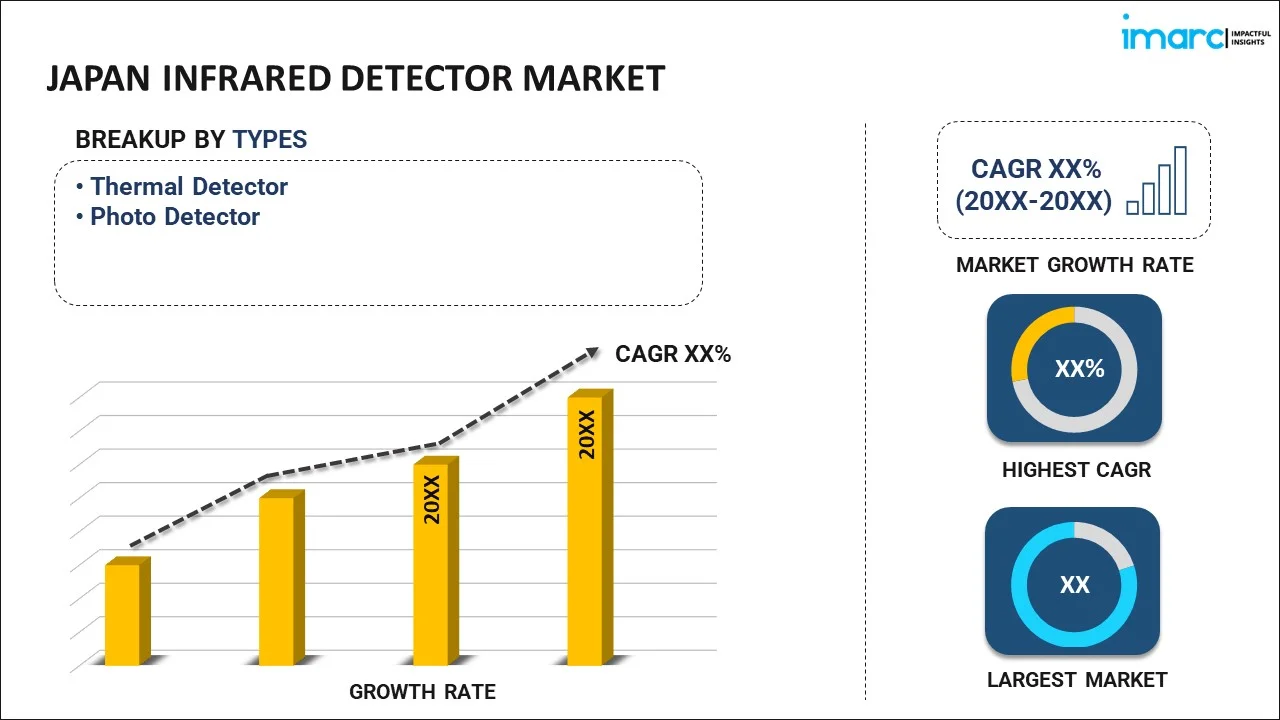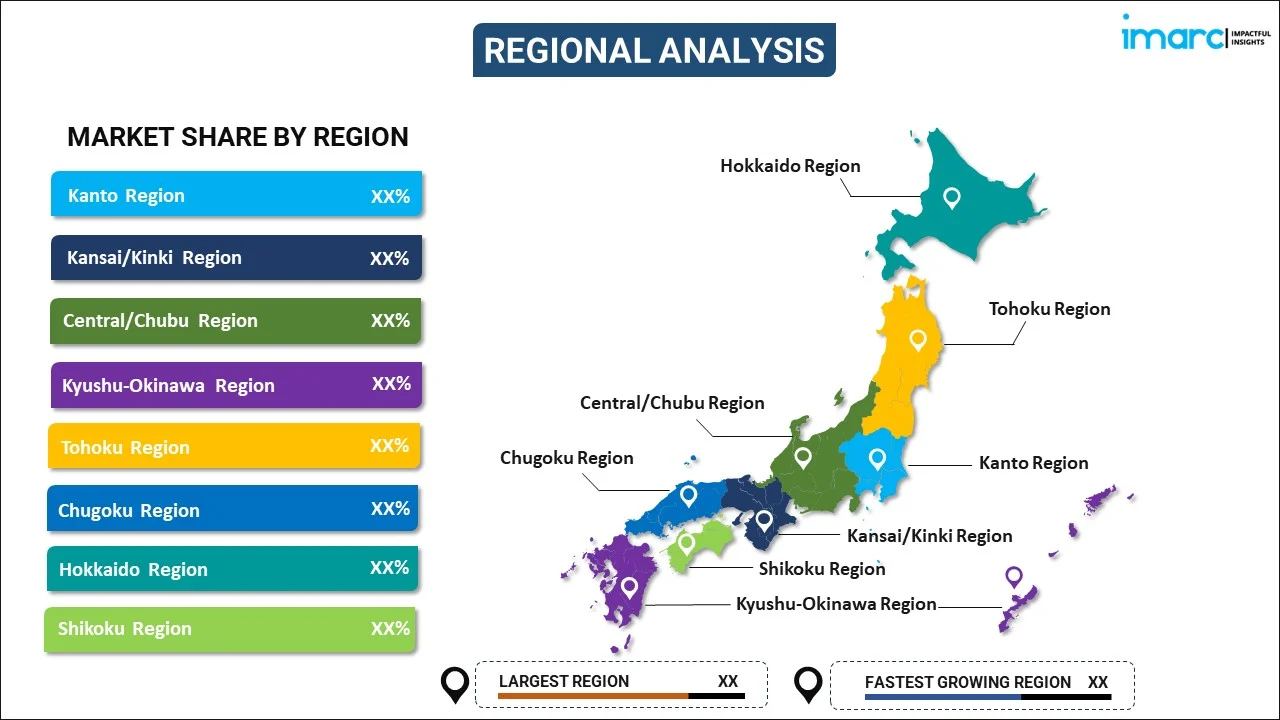
Japan Infrared Detector Market Report by Type (Thermal Detector, Photo Detector), Spectral Range (Short-wave Infrared, Medium-wave Infrared, Long-wave Infrared), Technology (Mercury Cadmium Telluride, Indium Gallium Arsenide (InGaAs), Pyroelectric, Thermopile, Microbolometer, and Others), Application (Aerospace and Defense, Automotive, Consumer Electronics, Industrial, Medical, Security), and Region 2025-2033
Market Overview:
Japan infrared detector market size reached USD 33.2 Million in 2024. Looking forward, IMARC Group expects the market to reach USD 67.8 Million by 2033, exhibiting a growth rate (CAGR) of 8.3% during 2025-2033. The increasing technological advancements in infrared radiation detector technology that have led to improved performance, reduced costs, and enhanced reliability, are driving the market.
|
Report Attribute
|
Key Statistics
|
|---|---|
|
Base Year
|
2024
|
|
Forecast Years
|
2025-2033
|
|
Historical Years
|
2019-2024
|
| Market Size in 2024 | USD 33.2 Million |
| Market Forecast in 2033 | USD 67.8 Million |
| Market Growth Rate 2025-2033 | 8.3% |
An infrared detector is a specialized electronic device designed to sense and capture infrared (IR) radiation, which is a form of electromagnetic radiation with longer wavelengths than visible light. These detectors are crucial in various applications, such as remote controls, thermal imaging cameras, security systems, and scientific research. Infrared detectors work on the principle of detecting the heat or thermal radiation emitted by objects or bodies. They typically utilize various technologies, including thermopiles, bolometers, and photodetectors, to convert IR radiation into an electrical signal. Thermopiles and bolometers rely on changes in temperature caused by the absorbed radiation, while photodetectors use semiconductor materials sensitive to IR photons. These detectors find extensive use in industries like aerospace, medicine, and environmental monitoring. For instance, night vision goggles enable the detection of heat signatures, making it possible to see in low-light or complete darkness. Infrared detectors have a wide range of applications due to their ability to sense temperature variations and provide valuable data in diverse fields.
Japan Infrared Detector Market Trends:
The infrared detector market in Japan is experiencing robust growth due to several key drivers, each playing a pivotal role in its expansion. Firstly, the increasing demand for enhanced security measures has propelled the adoption of infrared detectors in surveillance systems. These detectors offer superior night vision capabilities, making them indispensable for monitoring and safeguarding critical assets. Moreover, the growing need for energy-efficient solutions has driven the use of infrared detectors in building automation and smart home applications. As a result, they contribute to reducing energy consumption and enhancing overall environmental sustainability. Furthermore, the rise of the automotive industry has also significantly impacted the infrared detector market. The integration of infrared sensors in advanced driver-assistance systems (ADAS) enhances vehicle safety by enabling features like adaptive cruise control and collision avoidance. Additionally, the expanding healthcare sector, which has witnessed a surge in demand for infrared detectors, particularly in non-contact temperature measurement devices, is expected to drive the market in Japan in the coming years.
Japan Infrared Detector Market Segmentation:
IMARC Group provides an analysis of the key trends in each segment of the market, along with forecasts at the country level for 2025-2033. Our report has categorized the market based on type, spectral range, technology, and application.
Type Insights:

- Thermal Detector
- Photo Detector
The report has provided a detailed breakup and analysis of the market based on the Type. This includes thermal detector and photo detector.
Spectral Range Insights:
- Short-wave Infrared
- Medium-wave Infrared
- Long-wave Infrared
A detailed breakup and analysis of the market based on the Spectral Range have also been provided in the report. This includes short-wave infrared, medium-wave infrared, and long-wave infrared.
Technology Insights:
- Mercury Cadmium Telluride
- Indium Gallium Arsenide (InGaAs)
- Pyroelectric
- Thermopile
- Microbolometer
- Others
The report has provided a detailed breakup and analysis of the market based on the Technology. This includes mercury cadmium telluride, indium gallium arsenide (InGaAs), pyroelectric, thermopile, microbolometer, and others.
Application Insights:
- Aerospace and Defense
- Automotive
- Consumer Electronics
- Industrial
- Medical
- Security
A detailed breakup and analysis of the market based on the Application have also been provided in the report. This includes aerospace and defense, automotive, consumer electronics, industrial, medical, and security.
Regional Insights:

- Kanto Region
- Kansai/Kinki Region
- Central/ Chubu Region
- Kyushu-Okinawa Region
- Tohoku Region
- Chugoku Region
- Hokkaido Region
- Shikoku Region
The report has also provided a comprehensive analysis of all the major regional markets, which include Kanto Region, Kansai/Kinki Region, Central/ Chubu Region, Kyushu-Okinawa Region, Tohoku Region, Chugoku Region, Hokkaido Region, and Shikoku Region.
Competitive Landscape:
The market research report has also provided a comprehensive analysis of the competitive landscape. Competitive analysis such as market structure, key player positioning, top winning strategies, competitive dashboard, and company evaluation quadrant has been covered in the report. Also, detailed profiles of all major companies have been provided.
Japan Infrared Detector Market Report Coverage:
| Report Features | Details |
|---|---|
| Base Year of the Analysis | 2024 |
| Historical Period | 2019-2024 |
| Forecast Period | 2025-2033 |
| Units | Million USD |
| Scope of the Report | Exploration of Historical and Forecast Trends, Industry Catalysts and Challenges, Segment-Wise Historical and Predictive Market Assessment:
|
| Types Covered | Thermal Detector, Photo Detector |
| Spectral Ranges Covered | Short-wave Infrared, Medium-wave Infrared, Long-wave Infrared |
| Technologies Covered | Mercury Cadmium Telluride, Indium Gallium Arsenide (InGaAs), Pyroelectric, Thermopile, Microbolometer, Others |
| Applications Covered | Aerospace and Defense, Automotive, Consumer Electronics, Industrial, Medical, Security |
| Regions Covered | Kanto Region, Kansai/Kinki Region, Central/ Chubu Region, Kyushu-Okinawa Region, Tohoku Region, Chugoku Region, Hokkaido Region, Shikoku Region |
| Customization Scope | 10% Free Customization |
| Post-Sale Analyst Support | 10-12 Weeks |
| Delivery Format | PDF and Excel through Email (We can also provide the editable version of the report in PPT/Word format on special request) |
Key Questions Answered in This Report:
- How has the Japan infrared detector market performed so far and how will it perform in the coming years?
- What has been the impact of COVID-19 on the Japan infrared detector market?
- What is the breakup of the Japan infrared detector market on the basis of type?
- What is the breakup of the Japan infrared detector market on the basis of spectral range?
- What is the breakup of the Japan infrared detector market on the basis of technology?
- What is the breakup of the Japan infrared detector market on the basis of application?
- What are the various stages in the value chain of the Japan infrared detector market?
- What are the key driving factors and challenges in the Japan infrared detector?
- What is the structure of the Japan infrared detector market and who are the key players?
- What is the degree of competition in the Japan infrared detector market?
Key Benefits for Stakeholders:
- IMARC’s industry report offers a comprehensive quantitative analysis of various market segments, historical and current market trends, market forecasts, and dynamics of the Japan infrared detector market from 2019-2033.
- The research report provides the latest information on the market drivers, challenges, and opportunities in the Japan infrared detector market.
- Porter's five forces analysis assist stakeholders in assessing the impact of new entrants, competitive rivalry, supplier power, buyer power, and the threat of substitution. It helps stakeholders to analyze the level of competition within the Japan infrared detector industry and its attractiveness.
- Competitive landscape allows stakeholders to understand their competitive environment and provides an insight into the current positions of key players in the market.
Need more help?
- Speak to our experienced analysts for insights on the current market scenarios.
- Include additional segments and countries to customize the report as per your requirement.
- Gain an unparalleled competitive advantage in your domain by understanding how to utilize the report and positively impacting your operations and revenue.
- For further assistance, please connect with our analysts.
 Inquire Before Buying
Inquire Before Buying
 Speak to an Analyst
Speak to an Analyst
 Request Brochure
Request Brochure
 Request Customization
Request Customization




.webp)




.webp)












